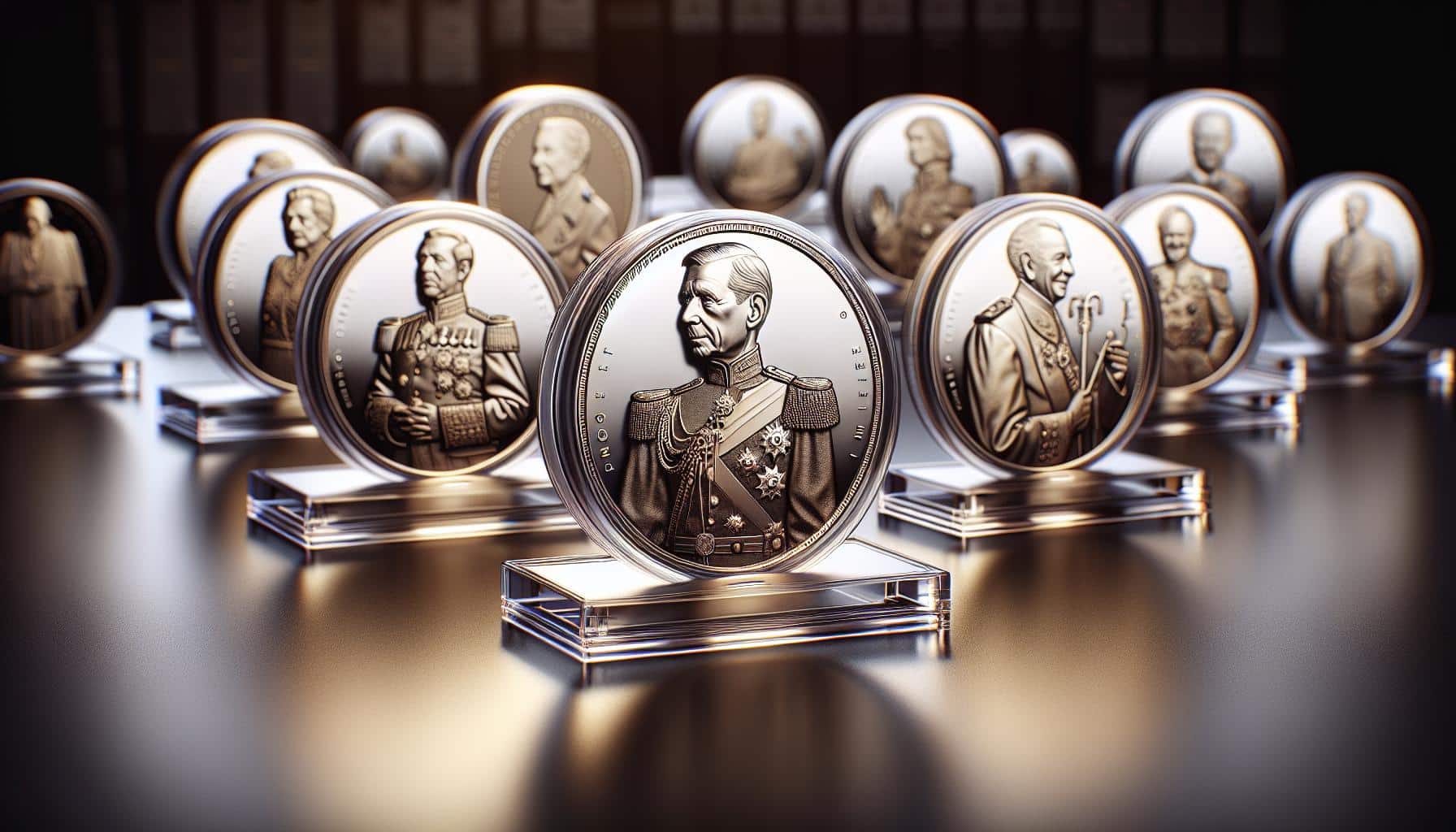Maximize Your Investment: Presidential Dollar Coin Value Guide
Have you ever wondered about the real worth of those presidential dollar coins you’ve been collecting? Well, you’re not alone. Many coin collectors and enthusiasts often find themselves questioning the value of their precious collections.
In the world of numismatics, the value of a coin isn’t just about its face value. It’s about rarity, condition, and demand too. This article will guide you through the fascinating world of presidential dollar coin value charts, shedding light on the factors that influence coin values.
Key Takeaways
- The Presidential Dollar Coin Collection, stemming from a program established in 2005, displays portraits of past US presidents on the currencies and contributes significantly to their value.
- The coins’ value is not only derived from their face value but also other factors like rarity, condition, and market demand. Thus, understanding a presidential dollar coin value chart requires knowledge of numismatic terms and US history.
- Price fluctuations in these coin values are typically influenced by their mintage, demand, and metal content. Lesser the coins produced, higher the value; demand from collectors can boost the coin’s value; intrinsic value of the metals used also contributes to the coin’s value, albeit less significantly.
- Investing in Presidential Dollar Coins offers both risks and rewards related to their value, condition, mint mark, and production figures. Therefore, understanding these factors can help formulate a wiser investment strategy.
- Coin grading is a fundamental process impacting the overall worth of Presidential dollar coins. Grading ranges from Basal or Poor (P-1) – the lowest grade- to Mint State or Uncirculated (MS-70) – the highest grade.
- Protecting and preserving the coin collection using appropriate storage techniques and insurance policies are key to maintaining and enhancing their value over time.
Understanding the Presidential Dollar Coin Collection
It’s important to appreciate the inherent beauty and value embedded in the Presidential Dollar Coin Collection. The making of this collection stems from a noteworthy program established to honor past presidents of the United States, reflecting American history in a unique way.
Origins of the Presidential Dollar Program
This program had its genesis in 2005. The United States Congress sanctioned the Presidential $1 Coin Act, intending to honor US presidents with distinctive coin designs. This practice offered a unique narrative focus, transcending the monetary value of the coins and cementing their historical importance.
The series, showcasing circulating dollar coins, commenced in 2007 and concluded in 2016, featuring presidents starting from George Washington to Ronald Reagan. It’s crucial to remember that only deceased presidents authorized for their portraits on coins, resulting in an exclusivity factor that stimulates demand in the collector’s market.
Key Features of the Coins
Each Presidential Dollar Coin comes embellished with distinctive design elements. The obverse of the coin showcases the portrait of the represented president along with their name, term, and position in the chronological order of the presidency. An accurate observation reveals examples like the “George Washington” coin, the first in the series, labeled “1st President 1789-1797”.
Moving on to the reverse, it portrays the Statue of Liberty, signifying the country’s hard-earned freedom. Unlike typical US coins, the dollar coin’s unique features expand to its edge lettering. Here, you’ll notice engravings of the year of issuance, mint mark, and the classic mottoes “In God We Trust” and “E Pluribus Unum”.
The Presidential Dollar Coin Collection offers not just a journey through American history but also exciting opportunities for numismatic enthusiasts. After understanding the origins and features of this collection, diving into the evaluation of each coin’s value becomes the next thrilling venture.
Dissecting the Presidential Dollar Coin Value Chart

Understanding a presidential dollar coin value chart requires familiarity with numismatic terms, an ability to grasp market trends, and a solid knowledge of U.S. history. This sophisticated scheme of evaluation goes beyond face value, considering aspects like mint mark, condition, and production figures.
Reading the Chart: Basics and Terms
A coin value chart serves primarily to assign a market value to your Presidential Dollar coins. To read the chart effectively, recognition of a few terms may prove beneficial. Terms such as “mint mark,” indicating the U.S. Mint facility that produced the coin, or “condition,” in other words, the coin’s state of preservation often directly impacts its value.
For instance, take “Uncirculated” and “Proof,” terms codifying coin conditions. “Uncirculated” symbolizes coins that showcase no trace of wear. Correspondingly, “Proof” refers to coin versions notably minted for collectors, recognized instantly by their mirror-like backgrounds and frosted features.
Here’s a mini chart to aid you in decoding the terms:
| Terms | Meaning |
|---|---|
| Mint Mark | Denotes the U.S. Mint facility |
| Condition | Coin’s state of preservation |
| Uncirculated | No trace of wear |
| Proof | Coin specifically minted for collectors |
Price Fluctuations: Factors affecting Coin Value
Simply put, the adage “what’s rare is dear” holds in the realm of coin collection too. Factors affecting coin value often incorporate mintage, demand, and metal content.
- Mintage – The fewer coins produced, the higher the value. For instance, Martin Van Buren’s proof coin (mintage of 2.2 million), stands at a higher echelon than that of George Washington’s (mintage of 4 million).
- Demand – Demand from collectors or, more precisely, the coin’s popularity can substantially enhance the coin’s value. Anticipatedly, the Presidential Dollar Collection’s allure is intrinsically linked with the rich tapestry of American history, thereby catalyzing demand.
- Metal content – The bulk of the coin comprises manganese-brass, yet contains a dash of copper, nickel, and zinc. Surprisingly, the intrinsic value of these metals makes up less of the coin’s value.
Thus, a presidential dollar coin value chart becomes a map, guiding collectors through an intricate terrain of supply, demand, and preservation status, facilitating an appreciation of these miniature monuments to history.
Evaluation of High-Value Presidential Dollar Coins
In this part of the numismatic journey, the focus shifts to some high-value specimens from the Presidential Dollar Coin Collection.
The 2007 George Washington Dollar Coin
The 2007 George Washington dollar coin, produced by the United States Mint, serves as one of the notable coins. It’s recognized for its historic significance, being the first coin in the collection. This coin carries the standard weight of 8.1 grams, as do all Presidential Dollar coins. The design, enhanced by its depiction of the first president, elevates its demand among collectors. Variations such as the Missing Edge Lettering error (coins released without their intended edge inscriptions) further increase its value. Thus, scrutinizing a presidential dollar coin value chart aids collectors in gauging the worth of this hidden gem.
The 2009 Zachary Taylor Dollar Coin
Another high-value contender in the collection is the 2009 Zachary Taylor Dollar coin. The twelfth coin in the series, it honors President Zachary Taylor. Though there’s no significant difference in terms of the technical specs compared to its counterparts, its popularity among numismatists boosts its value highly. Motivating factors such as historical relevance and the limited quantity produced causes a surge in its demand. Hence, a deep understanding of the presidential dollar coin value chart proves imperative to value the coin accurately.
Each Presidential Dollar coin’s value, influenced by distinct design appeal, personal historical relevance, and availability, turns an ordinary round metal into a treasure chest for numismatists. This section has showcased two such specimens – the 2007 George Washington and the 2009 Zachary Taylor dollar coins, and how understanding a presidential dollar coin value chart helps reveal their worth. The world of numismatics indeed offers an exciting exploration into the realm of history, artistry, and value. As you continue to explore, remember, every coin tells a tale. Understanding these tales often uncovers a wealth of history and value.
Investing in Presidential Dollar Coins
Investing in Presidential Dollar Coins brings its own set of challenges and opportunities. By understanding these factors, you’d formulate a wiser investment strategy.
Risk vs Reward: Should You Invest?
Investing in Presidential Dollar coins poses some risks and rewards. The primary risk lies in the coin’s value, significantly influenced by its condition, mint mark, and production figures. On the reward side, these coins offer unique values. For instance, the 2007 George Washington Dollar coin and the 2009 Zachary Taylor Dollar coin offer increased value amid their limited production, historical significance, and design appeal. Considering these aspects, investigating a potential investment in the Presidential Dollar coin collection may prove fruitful.
Collecting for Passion Versus Profit
Navigating the line between collecting coins for passion and profit varies. If it’s for passion, you’re likely drawn to the historical significance and uniqueness that the Presidential Dollar coin collection offers. Perhaps the allure of holding a piece of history in your hands or the appreciation of the artistry that goes into each coin fascinates you. Alternatively, if it’s for profit, you might assess the series’ potential financial return. Yet, in the lights of these factors, we note that the maga trump coin and the presidential dollar coin value chart hold significance to those who prioritize them. Lack of foresighted investing could lead to downfall in expected return, hence the role of a value chart to guide your decisions. From whatever perspective you approach it, collecting presidential dollar coins represents a meaningful and potentially rewarding endeavor.
Impact of Coin Grading on Value
When it comes to assessing the value of presidential dollar coins, understanding the coin grading system becomes key. It’s a fundamental process impacting their overall worth. Let’s dive deeper into the concept of coin grading and how it influences the rates as shown in the presidential dollar coin value chart.
Understanding the Coin Grading System
The coin grading system, originating in the 1940s, is a tool for determining the physical condition of coins. Grading ranges from Basal or Poor (P-1) – the lowest grade- to Mint State or Uncirculated (MS-70) – the highest grade. The scale encompasses the key attributes like the presence of mint marks, the condition of the coin, wear, and tear or discoloration.
For instance, consider a case of the 2007 George Washington Dollar Coin. A specimen in Mint State (MS-70) would be flawless, exactly as it left the mint, without wear and tear. In contrast, one rated Basal (P-1) may show significant wear, with almost all design details worn flat.
Grading’s Influence on Presidential Dollar Coin Prices
Coin grading holds substantial sway on the value of coins from the Presidential Dollar Coin Collection. The Mint grade example, like the George Washington Dollar Coin, could fetch a substantial premium over coins of lower grades. Suppose you come across a 2009 Zachary Taylor Dollar Coin in MS-70, according to the presidential dollar coin value chart; it’ll fetch more compared to a coin in a lesser grade.
In the world of numismatic enthusiasts, every coin tells a story. That history, combined with its physical state, is what sets its price. Understanding the grading system can be vital when investing in presidential dollar coins, whether to celebrate Trump with the MAGA Trump coin or to diversify your numismatic portfolio.
Maintaining utmost objectivity, Grading companies offer authenticity and clarity, helping collectors to understand the actual value of their coins. This evaluation process, though complex, is critical to maintaining investment effectiveness and ensuring legitimacy in the pursuit of numismatic wealth.
Remember, educating oneself ensures rewarding endeavors – take the risk and delve into the fascinating world of coin collection.
Protecting and Preserving Your Coin Collection
Collecting presidential dollar coins presents both a historical journey and an investment opportunity. Yet, maximizing the benefits depends on how well you protect and preserve your collection.
Proper Storage Techniques
Proper storage plays a crucial role in maintaining the exquisite condition of your coin collection. Exposure to hazards like humidity, dust, and extreme temperatures can degrade the coins, significantly affecting their value.
- Make use of coin holders, such as flips or capsules. These storage solutions provide a protective casing, reducing exposure to damaging environmental factors. For example, the 2007 George Washington Dollar Coin, kept in a flip holder, retains its condition longer than coins stored haphazardly.
- Ensure that the storage area is dry and cool. Conditions like high humidity and heat can cause discoloration or corrosion. Ideal storage conditions mean keeping the temperature steady around 70 degrees Fahrenheit and the relative humidity below 50%.
- Avoid handling the coins directly. Oils and dirt from hands can leave residues on the coins, tarnishing their shine. You might want to use latex gloves when handling your presidential dollar coins.
The Importance of Coin Insurance
In addition to physical preservation, safeguarding the financial value of your collection also merits consideration. Here’s where coin insurance enters the scenario. It offers coverage against potential losses due to unfortunate events, such as theft or destruction.
- Evaluate the total value of your collection. This involves delving into the details using a presidential dollar coin value chart. Remember to include the market value of higher graded coins, for instance, Mint State (MS-70) coins, offering larger payouts in case of loss.
- Purchase a separate insurance policy specifically designed for coin collections as standard homeowners insurance does not typically cover collectibles. For instance, if the 2009 Zachary Taylor Dollar Coin in your collection is stolen, only a coin insurance policy can help recover its exact value.
- Regularly update your insurance evaluation based on the current market value. Coins like the MAGA Trump Coin, popular among certain collector groups, may see fluctuations in their valuation. Regular updates in insured valuation ensure your coverage matches the value of your collection.
Protecting your investment takes more than simply understanding the presidential dollar coin value chart. Proper storage and insurance precautions are essentially tools in this numismatic journey, carving a path of security that transforms your collection from mere souvenirs to a timeless investment.
Conclusion
Taking your passion for collecting Presidential Dollar Coins to the next level isn’t just about recognizing their historical significance or understanding the grading system. It’s about transforming your collection into a secure investment. You’ve learned the importance of proper storage techniques and the role they play in preserving your coins’ value. You’ve also seen why insurance is crucial not just for peace of mind but also for safeguarding your collection’s financial worth. Remember, it’s not just about collecting coins; it’s about creating a lasting legacy that reflects the rich history of our past presidents. As you continue your journey in numismatics, keep these insights in mind. It’s your commitment to learning and adaptation that will ultimately determine the value of your collection.
What are Presidential Dollar Coins?
Presidential Dollar Coins are exclusive coins honoring past U.S. presidents with unique designs. Their historical significance and scarcity affect their monetary value in the collectors’ market.
What is coin grading and how does it influence their value?
Coin grading is a system to evaluate the condition of a coin. Higher-grade coins are in better condition and hence are more valuable. Understanding the grading system helps determine the actual worth of coins.
How important is proper storage for coins?
Proper storage is crucial to preserve the condition and value of coin collections. Techniques like using coin holders and maintaining ideal environmental conditions can protect a coin’s physical integrity.
Why is coin insurance important, and how should it be managed?
A separate coin insurance policy safeguards the financial value of your collection against potential losses or damages. It’s important to regularly update your policy based on market value to accurately reflect the worth of your collection.






 Bitcoin
Bitcoin  Ethereum
Ethereum  Tether
Tether  XRP
XRP  USDC
USDC  TRON
TRON  Lido Staked Ether
Lido Staked Ether  Dogecoin
Dogecoin  Figure Heloc
Figure Heloc  Cardano
Cardano  Bitcoin Cash
Bitcoin Cash  Wrapped stETH
Wrapped stETH  WhiteBIT Coin
WhiteBIT Coin  Wrapped Bitcoin
Wrapped Bitcoin  Wrapped eETH
Wrapped eETH  USDS
USDS  Chainlink
Chainlink  Binance Bridged USDT (BNB Smart Chain)
Binance Bridged USDT (BNB Smart Chain)  Monero
Monero  LEO Token
LEO Token  WETH
WETH  Stellar
Stellar  Coinbase Wrapped BTC
Coinbase Wrapped BTC  Sui
Sui  Ethena USDe
Ethena USDe  Litecoin
Litecoin  Zcash
Zcash  Avalanche
Avalanche  Hyperliquid
Hyperliquid  Shiba Inu
Shiba Inu  Hedera
Hedera  Canton
Canton  USDT0
USDT0  sUSDS
sUSDS  World Liberty Financial
World Liberty Financial  Dai
Dai  Toncoin
Toncoin  Cronos
Cronos  Ethena Staked USDe
Ethena Staked USDe  PayPal USD
PayPal USD  Uniswap
Uniswap  Polkadot
Polkadot  USD1
USD1  Mantle
Mantle  Rain
Rain  MemeCore
MemeCore  Bittensor
Bittensor  Pepe
Pepe